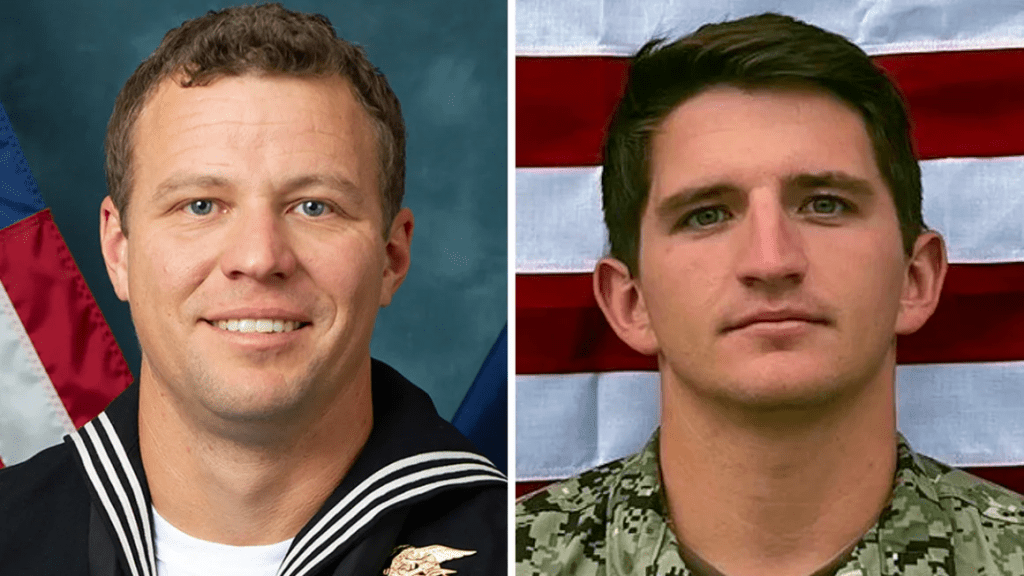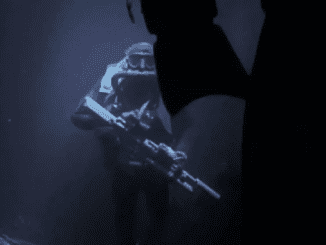
This Defense Department-provided image shows Navy Special Warfare Operator 1st Class Christopher J. Chambers, left, and Navy Special Warfare Operator 2nd Class Nathan Gage Ingram, right.
The drownings of two Navy SEALs during a maritime intercept off the coast of Somalia were preventable, caused by a lack of proper training and unclear guidance on effective flotation, a Navy investigation found.
During a night-time intercept of a ship carrying Iranian weapons to Yemen, Chief Special Warfare Operator Christopher Chambers and Naval Special Warfare Operator 1st Class Nathan Ingram fell into heavy seas while trying to board. Chambers, the Leading Petty Officer of the platoon, fell in from the side of the ship, while Ingram jumped into the water immediately to help.
Loaded with gear for the intercept mission, the two Navy SEALs went under in less than a minute. Chambers was seen “only intermittently” at the surface for 26 seconds; Ingram was seen “only intermittently” for 32 seconds.
“The entire tragic event elapsed in just forty-seven (47) seconds, and two [Naval Special Warfare] officers were lost to the sea,” the investigation found. “Encumbered by the weight of each individual’s gear, neither their physical capability nor emergency supplemental flotation devices, if activated, were sufficient to keep them at the surface.”
The findings by Naval Special Warfare Command mark the conclusion of a monthslong investigation to determine how two members of one of the most elite and highly trained teams in the US military drowned during a mission for which they had prepared.
“This incident, marked by systemic issues, was preventable,” wrote Gen. Michael “Erik” Kurilla, the commander of US Central Command, in his review of the investigation. Chambers and Ingram were posthumously promoted.
Naval Special Warfare SEAL Team Three deployed on board the USS Lewis B. Puller in December 2023. The team knew their primary mission would be maritime interceptions. That month, the team had carried out two successful boardings of similar ships known as dhows during daylight, the first in calm seas and the second in heavier seas.
In early January 2024, the Navy began tracking a slow-moving dhow over a period of several days. SEAL Team Three began planning an intercept of the vessel on or about January 12. Ultimately, the intercept was moved up one day after a review of the weather and an exercise of the operation.
At least one person involved in the operation, whose name is redacted in the investigation report, “voiced his concern about moving up the timing of the operation because it felt rushed.” In addition, “other crew members preferred to do it later to have more time to prepare.”
Even so, the investigation found that everyone in the group “offered an ‘ok’ and ‘good to go’” when asked about their ability to execute. The SEALs set out in approximately 6-to-7-foot seas, near the maximum height of 8 feet for such a nighttime operation. Conditions were difficult enough that the boarding craft had to approach three separate times. During the first two approaches, six SEALs were able to board.
But the third approach was more difficult, the investigation found. No one was controlling the dhow anymore since the crew had left the wheelhouse, and the vessel was rolling heavily in the weather. Chambers, 37, fell in while trying to board, and Ingram, 27, jumped into the water after him.
The Navy carried out search and rescue efforts for 10 days following the incident, covering a search area of 48,600 square miles, but teams were unable to recover the bodies of the two SEALs.
“In accordance with established Navy policy, recovery and salvage was not pursued as the sea is recognized as a fit and final resting place for the remains of members of the Naval Service,” the investigation report stated.
The investigation concluded that the Naval Special Warfare Force Readiness Manual highlights the importance of buoyancy, but it fails to provide specific guidance on what an effective buoyancy test entails.
Before deploying, the SEALs conducted pre-deployment buoyancy tests in the waters off San Diego, investigators said, but they failed to complete buoyancy tests after they embarked.
The Navy highlights the need for “positive buoyancy” – the ability to stay afloat – for boarding team members. Other materials focus on the need for “neutral buoyancy,” which is the ability to stay level in the water. Ultimately, it was up to individual team members to determine what type of buoyancy was required for a mission and to configure themselves. The lack of guidance led to “confusion and ineffective execution.”
The SEALs also lacked sufficient training with the Tactical Flotation Support System, an emergency flotation device, and it’s unclear if the two SEALs who drowned attempted to activate the system at all.
The investigation recommended a series of steps to address the “systemic issues” that led to the two drownings, including formalizing buoyancy requirements for missions, evaluating the need for a fail-safe flotation device and a review of lifesaving equipment on Navy boarding vessels.


